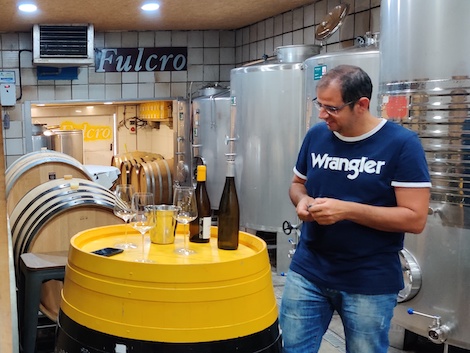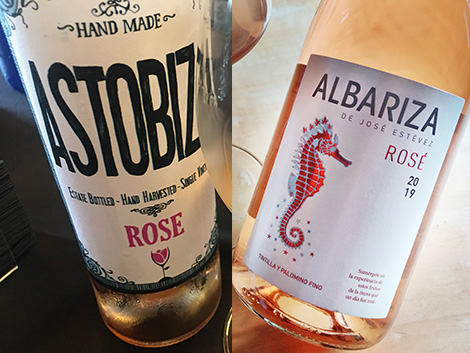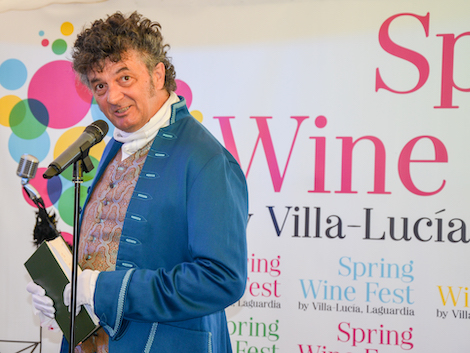Fulcro: new wines that enhance the diversity of Rías Baixas

Although he has not lived with his parents for a few years now, Manuel "Chicho" Moldes spends much of his time in the modest but very well-kept family property in Vilallonga, near Sanxenxo (Rías Baixas).
In this village of the Salnés valley, where, as in many others in the area, construction has gradually been replacing the vine pergolas, Chicho has a small winery-garage which, since 2009, has been filling up with wines and dreams.
Perhaps the coronavirus and the mildew of this annus horribilis have robbed him of his sleep, but not of his desire to grow steadily and to consolidate his brand Fulcro. As a matter of fact, he is going to build a new 200m² storage facility, thinking about the future and to avoid space problems. "We have enough wine, especially this year", explains Chicho, while we taste his whites and reds on the first barrel he filled with Fulcro O Equilibrio 2009. A witness to his beginnings, the barrel now enjoys a new life as a colourful tasting table thanks to his friend, the painter Paco Casal.
Word of mouth and Finca Xesteira
Much has changed since the day Chicho decided to leave his job as an economist in a bank to concentrate on wine full-time. It was a passion that he always shared with his father, who at that time made albariño for self-consumption in the family garage, where there was still room for the car, and with his friend Rodri Méndez (Forjas del Salnés), who lent him a hand in his first wines and with whom he maintains a close friendship today.
With a couple of rented hectares, he launched his first Albariños: A Pedreira, from the eponymous vineyard with degraded granite soils, and Fulcro O Equilibrio, which lends its name to the project. Both wines have evolved in finesse and volume, as Chicho has secured more vineyard, more barrels and more solidity in the project.
Pescuda has also evolved. That's the name of his entry level wine and surely one of the best value Albariños on the market, which serves as a kind of R&D to experiment with plots and barrels. Moldes progresses slowly but surely based on a principle that his father always reminds him of: "Look for vineyards only in places where there are old vines". To his dad's advice, he adds another of his own: "I try not to mess up the work on the vineyards and to blend the plots wisely, which is the art of making good wine".
All the vineyards he farms are rented out because, at over one million euros per hectare in the vicinity of Sanxenxo, close to beaches and tourist spots, prices are off-limits for small producers like him. "People inherit vineyards and don't want to work them; they prefer to spend time with their families. As the elderly can't work them, there' s an opportunity to rent and farm them. But sometimes it's near impossible to get them to rent the land,' explains Chicho.
Several of them have been found through word of mouth or are owned by friends, such as Finca Xesteira, whose Albariño vines, with ages ranging from 45 to 80, go to Fulcro O Equilibrio, until now his signature white. "The owner is an 87-year-old woman. Up until three years ago, she took care of it. Now we've raised the poles so that the tractor can access some parts of the vineyard, but we still do most of the work by hand," explains Chicho, who relies on the occasional help of his uncle in the vineyards, his father in the bottling machine, his brother, who owns Tinta Negra restaurant in Combarro, during the harvest, and his wife Silvia, who names the wines.
Unlike A Pedreira, the soils of Xesteira, one of his favourite sites, are sandy schist and contain kaolin, a type of clay that feels almost like talcum powder, and a very fine texture. The proximity to two tin and tungsten mines also makes them rich in minerals. "I don't have a preference for soils, but I do try to find what works best for each one. Both schist and granite do great in barrels, but granite performs better in seasoned oak," he adds.
One thing he acknowledges is his inability to work organically. Although air circulation in Xesteira and in the majority of his vineyards is good, when the vintage turns complicated and mildew strikes, it is difficult to treat with copper alone, says Chicho. "If your child has a headache, don't you give them an aspirin? If the conditions were different, we could switch our approach, but winters are not cold and that's essential. What we do try to do is prolong the treatments, but I think it's better to be safe than to have to tweak the wines at the end".
Recovering Espadeiro
On the terraces of Xesteira, overlooking the island of Ons and where the sea breeze always blows, Chicho has also grafted the hybrid Barrantes with some Caíño and especially with Espadeiro from Fabaíños, his vineyard with vines over 200 years old. Xesteira's grapes go to Aliaxe, the first red wine he made in the area (the Loureiro grapes in the blend, which add structure to the wine, come from a vineyard in Simes, further inland).
"Nursery-grown Espadeiro tends to have large leaves, unlike the old plants, which have less pronounced features," explains Chicho. "And as Eulogio de Zárate tells us, historically, Espadeiro was always planted in bush vines and Caíño was trellised". Now Chicho is trying different pruning methods, such as double and single Guyot, to see which system works best. What has not changed is the green cover, which stays all year round, and he only ploughs the vines every three to four years approximately - although others like A Pedreira, where the soil is not compact, are ploughed every six years.
The plant material to graft the Espadeiro comes from a small vineyard called Fabaíños, which was saved, says Chicho, "because it fell into the hands of someone whose livelihood did not lie in the vineyard". In the Salnés, vineyards planted with Espadeiro —and other traditional red varieties— were replanted with Albariño because it was more profitable and easier to grow. Fortunately, leading producers in Rías Baixas such as Moldes, Xurxo Alba (Albamar), Eulogio Pomares (Zárate and Fento Wines) and especially Rodri Méndez, whose grandfather never stopped cultivating them, are recovering these varieties.
When Chicho got hold of Fabaíños, the ferns crossed onto the vineyard, but between him and his uncle they cleaned it up and posted it on a trellis by hand. They slowly raised the wires to increase leaf mass and improve ripeness and do short prunings to discard fewer grapes, which is practically inevitable in a variety like Espadeiro.
"That's something the elders didn't do well in the past," explains Chicho. "Rodri tells the story of how when Raúl Pérez said that grapes had to be thrown away, his grandmother would say, 'Good God, if your grandfather were alive, you'd bury him again! Espadeiro bunches are very big. After 20 days of veraison you will see completely ripe bunches on top and green ones below. If you don't remove them, the grapes won't ripen. This is what happened to the Moldes family in 2017, their first vintage. "We still didn't control it very well. Now we run two passes: the first one when grapes start to ripen and another one 10 days before the harvest. If we see grapes that are not going to ripen, they are thrown away".
This technique and the prolonged extraction in the bodega (over 30 days) seem to have yielded results, because if Aliaxe Fabaíños 2017 seemed to us to be one of the most fascinating wines we tasted last year, their 2018 vintage, with 11.5% abv and tremendous finesse, is frankly spectacular. None of them have been released yet, so we will have to be on the lookout for some of the few bottles (420 litres in 2017 and 310 in 2018) when they do finally hit the market.
Nas Dunas and A Cesteira, two new whites
Another yet to be released wine is Fulcro Nas Dunas. It is a super-fine Albariño from old, thin vines in Arra, a high area above Montalvo beach with sandy soils on clay where the wine making tradition is very old (the Armenteira monastery nearby collected taxes in wine). It is a joint project with Rodri Méndez and Raúl Pérez —a sort of Galician Rapolao— as each of them has also made a wine from this very special vineyard, planted in the 1940s, which even in warm years produces spectacular grapes.
They had been chasing these vineyards for quite some time, but two years ago they were finally able to buy 300kg of grapes each thanks to the fact that the owner, who sold the wine from this plot on his furancho (bars that sell basic local wine), decided to retire. Although Chicho is not in charge of the viticulture, he has no complaints about the quality of the white grapes, which do veraison 10 days earlier than other plots, even though this vineyard is more exposed. "They're great growers; you don't have to explain anything to them; on the contrary, you have to ask them because they've been cultivating them all their lives," he adds. And what are these sand-grown wines like? "For me they are spectacular and very elegant. We thought they might be leaner and fruitier, but they are really well rounded," asserts Chicho, who keeps the 2018 and 2019 vintages in the winery, the latter being his favourite in whites.
Another vineyard he has take over recently is an Albariño plot with clay, mica and some degraded granite soils in Góndar, a few kilometres from the winery, located in the property where its owner lives. Although the 2017 wine was "spectacular", yields were low so it was blended in A Pescuda, but in the future it will be released as A Cesteira. The 2019 vintage, still in the cellar and ageing in stainless steel tanks and seasoned wood, is full-bodied and has good volume. Around 800 bottles will be released, but according to Chicho, there is room for growth up to 4,000 bottles.
He now dreams of restoring the splendour of an old Espadeiro vineyard adjacent to Fabaíños, which, like this one not long ago, is abandoned. "It would be great to have more Espadeiro, because it would really sharpen the Aliaxe blend, which could be 40 Caíño, 40 Espadeiro and 20 Loureiro (it's now 60, 20, 20). Caíño can become elegant over time, but Espadeiro is born that way.
In his pursuit of finesse, he would like to have foudres for Fulcro and A Pedreira but Chicho is aware that things take time. "One needs to be able to handle vanity. It's like music: a musician aspires to play in the most iconic places; the same goes for wine. You want to rub shoulders with the greatest and that forces you to invest more, but you have to go step by step and learn to control that urge".

Yolanda Ortiz de Arri
A journalist with over 25 years' experience in national and international media. WSET3, wine educator and translator
Wine tastings in September 2020
NEWSLETTER
Join our community of Spanish wine lovers






